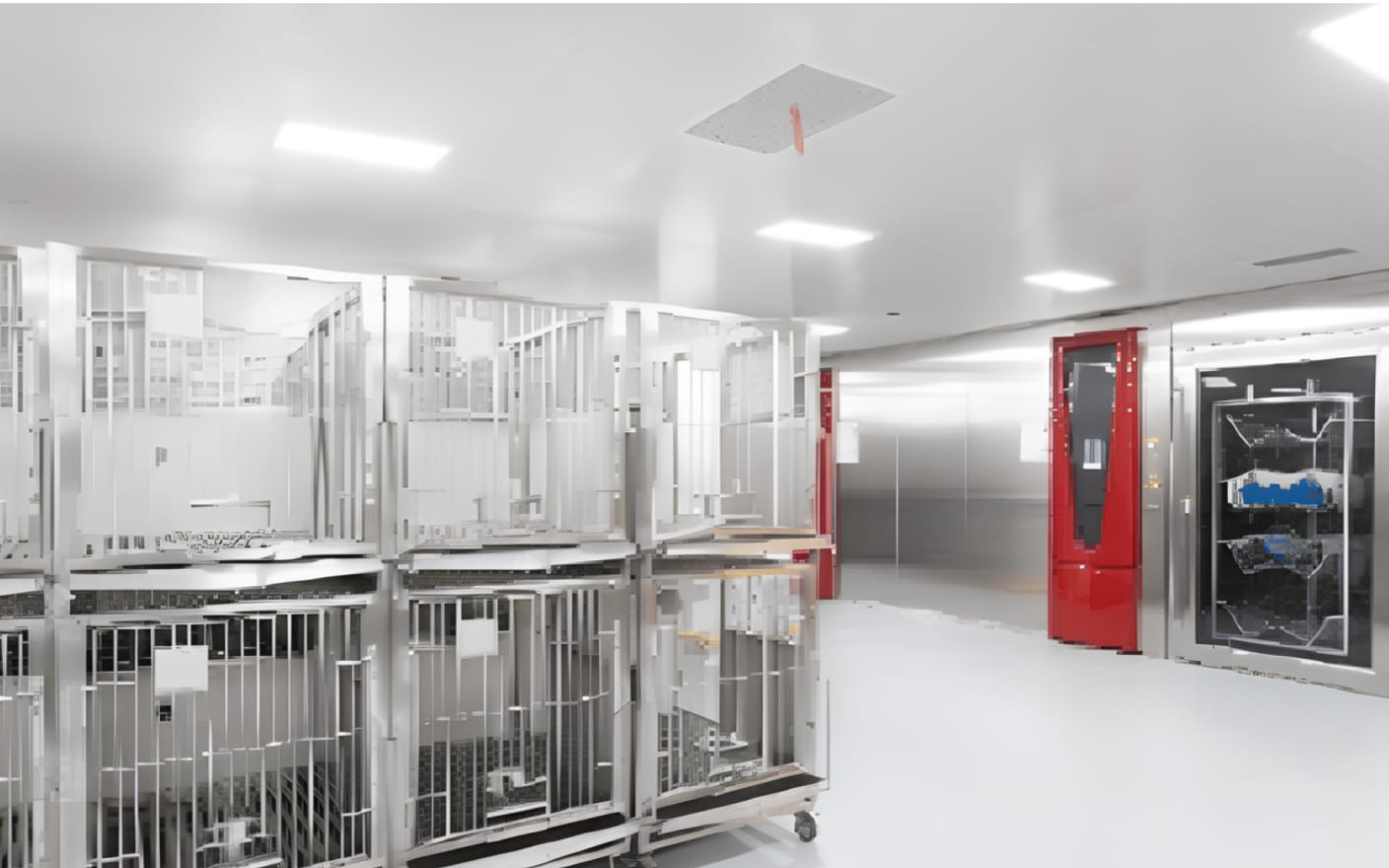Owing to the advancement of medical, pharmaceutical, and our understanding of pulmonary function and diseases like asthma and chronic obstructive pulmonary disease (COPD), inhaled delivery has been considered the simplest and most effective administration route of respiratory diseases 1. According to market statistics, the sales of inhaled drugs, including aerosol, dry powder, and sprays, have consistently risen over the past decade. In 2014, the market sales were approximately 9.3 billion USD, with the expected sales of approximately 18.4 billion USD by 2026, almost double the sales in 2014 (Figure 1) 2. As such, inhaled drug delivery is garnering increasing attention in the pharmaceutical industry.

Figure 1. Market size of inhaled drugs2
Understanding inhaled delivery requires a comprehensive knowledge of the intricate structure of the respiratory system, which consists of the respiratory tract (the nose, pharynx, larynx, trachea, and bronchi) and alveoli. Respiratory disease lesions primarily occur in the trachea, bronchi, lungs, and chest cavity. Therefore, inhaled delivery could directly target the disease areas to treat respiratory system diseases. The processes of drug absorption, distribution, and metabolism or excretion within the body after inhalation are illustrated in Figure 23.

Figure 2. Pharmacokinetic processes in vivo after inhaled delivery3
As shown in Figure 2, inhaled delivery directly targets tissues in the lungs, provides rapid onset of action, and reduces the required drug dose and systemic drug exposure, thereby lowering the risk of potential systemic toxicity. Additionally, the alveolar cells are thin and there are abundant blood vessels on the alveolar surface, which facilitates the absorption of drugs intended for systemic therapeutic effects through inhalation. This can also bypass first-pass metabolism in the liver, increasing bioavailability in the lungs. Moreover, the treatment of respiratory system diseases often needs long-term medication, and inhaled delivery is non-invasive and requires only simple devices, which can enhance patient compliance. Because of these pronounced advantages, inhaled delivery has attracted considerable attention in the pharmaceutical industry. However, there are still numerous challenges in the development of inhaled drugs. This article discusses the challenges and strategies for the development of inhaled drugs.
Challenges in the development of inhaled drugs
After inhalation, not all of the drug will deposit in the lungs, with 40–90% of drugs getting deposited in the oropharynx instead 4. One major challenge faced by the development of inhaled drugs is the improvement of pulmonary bioavailability while decreasing systemic exposure.
Increasing pulmonary bioavailability could consider two methods: increasing the rate of lung deposition and prolonging lung retention.
(1) Increasing pulmonary deposition rates
There are three forms of movement in which drug particles enter the respiratory tract after inhalation: inertial impaction, gravitational sedimentation, and Brownian motion (Figure 3). In the upper respiratory tract, larger particles are more likely to deposit owing to inertial impaction against the tracheal wall. In the middle to end regions of the bronchi, drug particles deposit at different locations under the gravitational action. However, in the alveoli, the small drug particles may be exhaled during expiration. According to the literature 3, larger particles tend to deposit more in the oropharynx. On the other hand, extremely small drug particles tend to have low total deposition in the respiratory tract. Therefore, lung deposition is closely related to the size of the drug particles. The general distribution pattern based on particle size is summarized (Figure 4):
-
Particles with aerodynamic diameters of 1–5 μm show the best pulmonary deposition rates.
-
Particles >5 μm tend to deposit in the oral cavity and trachea.
-
Particles <1 μm will quickly be exhaled from the lungs with the airflow.

Figure 3. Deposition of drug particles in different parts of the respiratory system 5

Figure 4. Relationship between location of deposition and drug particle size3
(2) Prolonging lung retention
The rate at which a drug dissolves in the epithelial lining fluid determines its absorption rate. Rapid dissolution results in rapid systemic absorption, whereas slower dissolution promotes longer retention in the lungs. Consequently, prolonging the dissolution time will increase retention time in the lungs.
The intrinsic solubility of a compound is a major factor affecting the dissolution rate. Structural modifications could be used to reduce a compound’s solubility or alter its crystal structure. For example, fluticasone used in the treatment of asthma and chronic obstructive pulmonary disease has low solubility (approximately 100 ng/mL). It takes more than 8 hours for Fluticasone microcrystals to completely dissolve in human bronchial fluid, resulting in a relatively long average absorption time in the lungs (5–7 h).
New formulation technologies can be employed to regulate the rate of drug release in the lungs. For instance, liposomes or microspheres can be used to achieve optimal drug release rates, and drug coatings, such as biodegradable polymer nanofilm coatings or trehalose-based coatings, can ensure slow drug release in the lungs.
In addition to enhancing the distribution and absorption of drugs in the lungs, the rate of drug-target dissociation could be lowered by improving target binding kinetics and drug structure. Fluticasone is a long-acting receptor antagonist and a new-generation inhaled corticosteroid, an example of this strategy. Compared to dexamethasone, fluticasone exhibits a high binding rate and percentage to the glucocorticoid receptor (binding constant kl is 23.9 × 105 L mol−1min−1 for fluticasone and 12.5 × 105 L mol−1min−1 for dexamethasone.). Moreover, the fluticasone-receptor complex has a slower dissociation rate (dissociation constant k-1 is 13.2 × 10-4 min−1 for fluticasone and 11.7 × 10−3 min−1 for dexamethasone) 6.
To reduce systemic exposure to inhaled drugs, it is necessary to consider three aspects, including absorption, distribution, and metabolism.
-
Absorption: Oral bioavailability can be reduced by lowering permeability, decreasing solubility, and increasing molecular weight.
-
Distribution: The free concentration of drugs in the plasma can be decreased by increasing plasma protein binding.
-
Metabolism: Drugs can be rapidly metabolized into inactive metabolites in the liver.
In addition to optimizing the drug's physicochemical properties, formulations, and target binding, the appropriate inhalation device could be selected to optimize drug delivery and deposition in the lungs.
Choice of inhalation device
There are three common types of inhalation devices for inhaled delivery in clinical trials: pressurized metered-dose inhalers (pMDIs), dry powder inhalers (DPIs), and nebulizers (Figure 5). Moreover, four common types of inhalation devices are commonly used in preclinical studies: aerosol exposure chambers, intranasal delivery devices, pulmonary delivery nebulizers, and nose-only exposure inhalation towers.

Figure 5. Three types of inhalation devices in clinical
Inhaled delivery techniques and study design for preclinical in vivo PK studies
(1) Selection of inhalation devices for preclinical PK studies
The choice of drug delivery device should be based on various factors, including the drug development stage, formulation type, and quantity of the compound. In the early stages of drug development, only limited quantities of the compound are available, and intranasal or intratracheal administration can be chosen to study the pulmonary PK properties using a small amount of the compound. If an ample supply of the compound is available, a nose-only exposure inhalation tower can be used for drug research. Figure 6 shows the strategies for inhalation device selection, dose determination, and compound properties requirements at each stage of preclinical development.

Figure 6. Preclinical study design for inhaled delivery
(2) Preclinical study design for inhaled delivery
In preclinical PK studies, different inhalation devices are used for different study designs. The dosage designs are summarized in Table 1.
|
Routes of administration |
Formulation types |
Dosage calculation |
|
Intranasal administration |
Solution Dry powder |
Solution formulation: Dose administered (mg/kg) = formulation concentration (mg/mL) × volume administered (mL/kg) |
|
Intra-tracheal administration |
Solution Dry powder |
|
|
Nose only exposure |
Solution Dry powder |
Delivered dose* (mg/kg) = (aerosol concentrationa × animal ventilation per minb × inhalation duration)/ animal weight 5 |
Table 1. Dosage designs for different administration methods
*The delivered doses are not fully deposited in the lungs. According to the literature, pulmonary deposition rates are generally 10% of the delivered dose in rodents and 25% in non-rodents 7.
a. Aerosol concentration is determined by instruments like filters, photometers, U-tubes, aerodynamic particle sizers, cascades, and disc impingers.
b. Ventilation per min (L/min) = 0.608 × body weight (kg)^0.852
(3) Sampling design
In PK studies on respiratory diseases, in addition to routine plasma collection, special attention should be paid to the distribution of the drug in the respiratory tract and drug concentration in the bronchoalveolar lavage fluid.
|
Sampling site |
Sample type |
|
Nasal sampling |
Nasal contents |
|
Nasal lavage |
|
|
Lung sampling |
Bronchoalveolar lavage fluid (BAL, calculated ELF concentration*) |
|
Trachea |
|
|
Lung |
Table 2. Sampling designs of inhaled delivery in airway tissues.
*The epithelial lining fluid (ELF) of the lungs is important for understanding the mechanisms of acute lung injury, inflammatory lung disease, and PK studies. Bronchoalveolar lavage is a technique for sampling the ELF from the lung, but it also may result in dilution of the ELF. To quantify the apparent volume of ELF obtained by bronchoalveolar lavage, urea is used as an endogenous marker of ELF dilution. As urea diffuses readily in the body and the concentration of urea in plasma/serum and ELF is the same, a simple dilution principle can be used to calculate the ELF volume 8, which could be converted to the drug concentration in the ELF.
(4) Data analysis
A clear solution formulation and dry powder were administered to Sprague–Dawley (SD) rats via the trachea at a dose of 0.5 mg/kg, and plasma, BAL, and lung tissue samples were collected at 2 min, 10 min, 30 min, 1 h, 2 h, and 4 h after dosing (Figure 7).
A suspension formulation was orally administered to SD rats at a dose of 50 mg/kg, and plasma, BAL, and lung tissue samples were collected at 15 min, 30 min, 1 h, 2 h, 4 h, and 8 h after dosing (Figure 7).

Figure 7. Pharmacokinetics of intratracheal and oral administration
Based on the area under the curve (AUC) (plasma concentration multiplied by time) per unit dose, the order of systemic exposure levels among these dosing groups was: solution formulation via intratracheal nebulization administration > dry powder via intratracheal administration > suspension formulation via oral administration. However, based on the AUC per unit dose in the lungs, BAL, and ELF, pulmonary exposure levels for each dosing group follow the order: dry powder via intratracheal administration > solution formulation via intratracheal nebulization > suspension formulation via oral administration. Intratracheal administration resulted in higher pulmonary deposition and in vivo absorption than oral administration. Due to the longer dissolution time of the dry powder in the lungs, a higher lung-to-blood ratio was observed in the dry powder than in the solution formulation, which increase drug retention and bioavailability in the lungs (Table 3).
|
PK parameters |
Intra-tracheal nebulization of solution formulation |
Intra-tracheal administration of dry powder formulations |
Oral administration of solution formulations |
|||||||||
|
Plasma |
Lungs |
LBA |
ELF |
Plasma |
Lungs |
BAL |
ELF |
Plasma |
Lungs |
BAL |
ELF |
|
|
Cmax (ng/mL or ng/g) |
3,164 |
9,792 |
2,594 |
9,254 |
355 |
12,940 |
3,865 |
80,007 |
992 |
7,949 |
611 |
5,384 |
|
AUC0-last (ng.h/mL or ng.h/g) |
423 |
12,137 |
1,324 |
9,006 |
62 |
32,826 |
9,719 |
218,012 |
4,298 |
38,626 |
3218 |
23,365 |
|
AUC ratio (lung tissue/plasma) |
- |
28.7 |
3.13 |
21.5 |
- |
529 |
157 |
3,513 |
- |
8.99 |
0.749 |
5.44 |
|
AUC/dose administered |
846 |
24,274 |
2,628 |
18,012 |
124 |
65,652 |
19,438 |
436,024 |
86.0 |
772 |
64.3 |
467 |
Table 3. Compound pharmacokinetics (PK) with tracheal and oral administration
Cmax: Peak plasma concentration
AUC0-last: The area under the plasma concentration-time curve from time zero to the last quantifiable concentration
Preclinical inhaled drug delivery platform
The inhaled delivery platform possessed by the WuXi AppTec DMPK includes intranasal administration, intratracheal administration, and nose-only exposure inhalation systems, which satisfy the needs of inhalation drug research at all preclinical stages (Table 4).
|
Drug delivery device |
Characteristics |
Scope |
|
Intranasal delivery devices |
Direct administration, simple operation, precise dosing, drugs can easily cross the blood-brain barrier |
Animal studies with rats, mice, monkeys, dogs, e etc. |
|
Intratracheal nebulizer |
Direct administration, precise dosing, avoiding deposition in the oral or nasal cavity, rapid drug delivery, and minimal drug loss. Performed on animals under mild sedation or anesthesia, suitable for a single dose or multiple-day intervals; multiple doses may cause local irritation |
Animal experiments with rats, mice, monkeys, dogs, etc. |
|
Nose-only exposure inhalation tower |
Spontaneous inhalation of the drug by the animals Administered when the animal is awake, can be used for multiple dosages Deposition of the drug in the lungs depends on the animal's respiration, and deposition will occur in the oropharynx, which results in high drug consumption levels |
Animal experiments with rat and mice models |
Table 4. Preclinical inhaled drug delivery platform
(1) Intranasal administration (Figures 8 and 9).

Figure 8. Intranasal instillation

Figure 9. Intranasal nebulization
(2) Intratracheal administration (Figures 10 and 11).

Figure 10. MicroSprayer Aerosolizer

Figure 11. DPI specific Syringe
(3) Inhalation delivery through respiratory exposure tower (Figure 12).

Figure 12. Inhalation delivery through respiratory exposure tower
Conclusion
Approximately 300 million people worldwide suffer from chronic pulmonary diseases and endure breathing difficulties. There is a clinical need for more effective inhaled drugs with fewer side effects. This article summarizes the challenges and strategies for preclinical in vivo PK studies of inhaled delivery, aiming to facilitate the development of respiratory disease medications and bring hope to patients.
If you want to learn more details about the strategies for inhaled drugs, please talk to a WuXi AppTec expert today to get the support you need to achieve your drug development goals.
Authors: Yingying Li, Lijuan Hou, Xuan Dong, Jing Jin, Cheng Tang
Committed to accelerating drug discovery and development, we offer a full range of discovery screening, preclinical development, clinical drug metabolism, and pharmacokinetic (DMPK) platforms and services. With research facilities in the United States (New Jersey) and China (Shanghai, Suzhou, Nanjing, and Nantong), 1,000+ scientists, and over fifteen years of experience in Investigational New Drug (IND) application, our DMPK team at WuXi AppTec are serving 1,500+ global clients, and have successfully supported 1,200+ IND applications.
Reference
[1] 雷婷婷,赵荣生。雾化吸入给药的临床应用现状及研究进展[J].临床药学治疗杂志,2016,vol.14, no.3
[2] Inhalable Drugs Market Size, Share & Trends Analysis Report By Product (Aerosol, Dry Powder Formulation, Spray), By Application (Respiratory & Non-Respiratory Diseases), And Segment Forecasts, 2019 – 2026
[3] Jens Markus Borghardt etc. Inhaled Therapy in Respiratory Disease: The Complex Interplay of Pulmonary Kinetic Processes. Canadian Respiratory Journal, Volume 2018, Article ID 2732017, 11 pages
[4] Günther Hochhaus etc. Pharmacokinetics of Orally Inhaled Drug Products. The AAPS Journal, Vol. 17, No. 3, May 2015
[5]Huge D.C. Smyth, Anthony J. Hickey. Controlled Pulmonary Drug Delivery.
[6] P Högger, P Rohdewald. Binding kinetics of fluticasone propionate to the human glucocorticoid receptor. Steroids. 1994, vol 59, Pages 597-602
[7] David J. Alexander, etc. Association of Inhalation Toxicologists (AIT) Working Party Recommendation for Standard Delivered Dose Calculation and Expression in Non-Clinical Aerosol Inhalation Toxicology Studies with Pharmaceuticals. Inhalation Toxicology, 20:1179–1189, 2008
[8] STEPHEN I. RENNARD, etc. Estimation of volume of epithelial lining fluid recovered by lavage using urea as a marker of dilution. J Appl Physiol (1985), 1986 Feb; 60(2):532-8
Related Services and Platforms




-

 In Vivo PharmacokineticsLearn More
In Vivo PharmacokineticsLearn More -

 Therapeutic Areas DMPK Enabling PlatformsLearn More
Therapeutic Areas DMPK Enabling PlatformsLearn More -

 Rodent PK StudyLearn More
Rodent PK StudyLearn More -

 Large Animal (Non-Rodent) PK StudyLearn More
Large Animal (Non-Rodent) PK StudyLearn More -

 Clinicopathological Testing Services for Laboratory AnimalsLearn More
Clinicopathological Testing Services for Laboratory AnimalsLearn More -

 High-Standard Animal Facilities and Animal WelfareLearn More
High-Standard Animal Facilities and Animal WelfareLearn More -

 Preclinical Formulation ScreeningLearn More
Preclinical Formulation ScreeningLearn More
Stay Connected
Keep up with the latest news and insights.











